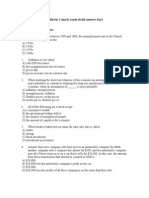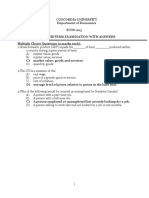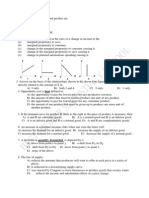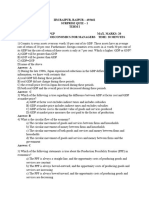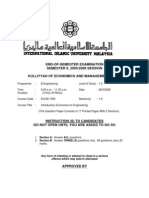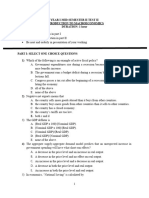Macro Qch1
Macro Qch1
Uploaded by
Kiều AnhCopyright:
Available Formats
Macro Qch1
Macro Qch1
Uploaded by
Kiều AnhOriginal Title
Copyright
Available Formats
Share this document
Did you find this document useful?
Is this content inappropriate?
Copyright:
Available Formats
Macro Qch1
Macro Qch1
Uploaded by
Kiều AnhCopyright:
Available Formats
Questions and Answers
Chapter 1
Q1: MCQ
1. Macroeconomics approaches the study of economics from the viewpoint of:
A) the entire economy.
B) governmental units.
C) the operation of specific product and resource markets.
D) individual firms.
Answer: A
2. Which of the following is associated with macroeconomics?
A) an examination of the incomes of Harvard Business School graduates
B) an empirical investigation of the general price level and unemployment rates since 1990
C) a study of the trend of pecan prices since the Second World War
D) a case study of pricing and production in the textbook industry
Answer: B
3. The problems of aggregate inflation and unemployment are:
A) major topics of macroeconomics. C) major topics of microeconomics.
B) not relevant to the U.S. economy. D) peculiar to command economies.
Answer: A
4. Which of the following statements pertains to macroeconomics?
A) Because the minimum wage was raised, Mrs. Olsen decided to enter the labor force.
B) A decline in the price of soybeans caused farmer Wanek to plant more land in wheat.
C) The national productivity rate grew by 2.7 percent last year.
D) The Pumpkin Center State Bank increased its interest rate on consumer loans by 1
percentage point.
Answer: C
5. Macroeconomics can best be described as the:
A) analysis of how a consumer tries to spend income.
B) study of the large aggregates of the economy or the economy as a whole.
C) analysis of how firms attempt to maximize their profits.
D) study of how supply and demand determine prices in individual markets.
Answer: B
6. Nominal GDP is:
A) the sum of all monetary transactions that occur in the economy in a year.
1 Principles of Macroeconomics- Chapter 1
B) the sum of all monetary transactions involving final goods and services that occur in the
economy in a year.
C) the amount of production that occurs when the economy is operating at full
employment.
D) money GDP adjusted for inflation.
Answer: B
7. Real GDP refers to:
A) the value of the domestic output after adjustments have been made for environmental
pollution and
changes in the distribution of income.
B) GDP data that embody changes in the price level, but not changes in physical output.
C) GDP data that reflect changes in both physical output and the price level.
D) GDP data that have been adjusted for changes in the price level.
Answer: D
8. Real GDP measures:
A) current output at current prices. C) base year output at current prices.
B) current output at base year prices. D) base year output at current exchange rates.
Answer: B
9. Nominal GDP is adjusted for price changes through the use of:
A) the Consumer Price Index (CPI). C) the GDP price index.
B) the Producer Price Index (PPI). D) exchange rates.
Answer: C
10. A price index is:
A) a comparison of the price of a market basket from a fixed point of reference.
B) a comparison of real GDP in one period relative to another.
C) the cost of a market basket of goods and services in a base period divided by the cost of
the same market basket in another period.
D) a ratio of real GDP to nominal GDP.
Answer: A
11. The GDP price index:
A) includes fewer goods and services than the consumer price index.
B) is identical to the consumer price index.
C) is another term for the producer price index.
D) includes all goods comprising the nation's domestic output.
Answer: D
12. If real GDP falls from one period to another, we can conclude that:
A) deflation occurred. C) nominal GDP fell.
B) inflation occurred. D) none of the above necessarily occurred.
Answer: D
2 Principles of Macroeconomics- Chapter 1
13. If real GDP in a particular year is $80 billion and nominal GDP is $240 billion, the
GDP price index for that year is:
A) 100. B) 200. C) 240. D) 300.
Answer: D
14. Suppose a nation's 2003 nominal GDP was $972 billion and the general price index
was 90. To make the 2003 GDP comparable with the base year GDP, the 2003 GDP
must be:
A) adjusted downward to $678 billion. C) inflated to $1080 billion.
B) deflated to $896 billion. D) deflated to $1080 billion.
Answer: C
15. Real GDP and nominal GDP differ because the real GDP:
A) is adjusted for changes in the volume of intermediate transactions.
B) includes the economic effects of international trade.
C) has been adjusted for changes in the price level.
D) excludes depreciation charges.
Answer: C
16. If nominal GDP rises:
A) real GDP may either rise or fall. C) real GDP must fall.
B) we can be certain that the price level has risen. D) real GDP must also rise.
Answer: A
17. Real GDP is:
A) the nominal value of all goods and services produced in the economy.
B) the nominal value of all goods and services produced in the domestic economy corrected
for inflation or deflation.
C) that aggregate output that is produced when the economy is operating at full
employment.
D) always greater than nominal GDP.
Answer: B
18. In comparing GDP data over a period of years, a difference between nominal and real
GDP may arise because:
A) of changes in trade deficits and surpluses.
B) the length of the workweek has declined historically.
C) the price level may change over time.
D) depreciation may be greater or smaller than gross investment.
Answer: C
19. The phase of the business cycle in which real GDP declines is called:
A) the peak. B) a recovery. C) a recession. D) the trough.
Answer: C
3 Principles of Macroeconomics- Chapter 1
20. The phase of the business cycle in which real GDP is at a minimum is called:
A) the peak. B) a recession. C) the trough. D) the pits.
Answer: C
21. A recession is a period in which:
A) cost-push inflation is present. C) demand-pull inflation is present.
B) nominal domestic output falls. D) real domestic output falls.
Answer: D
22. Kimberly voluntarily quit her job as an insurance agent to return to school full-time
to earn an MBA degree. With degree in hand she is now searching for a position in
management. Kimberly presently is:
A) cyclically unemployed. C) frictionally unemployed.
B) structurally unemployed. D) not a member of the labor force.
Answer: C
23. To be officially unemployed a person must:
A) be in the labor force. C) have just lost a job.
B) be 21 years of age or older. D) be waiting to be called back from a layoff.
Answer: A
24. The natural rate of unemployment is:
A) higher than the full-employment rate of unemployment.
B) lower than the full-employment rate of unemployment.
C) that rate of unemployment occurring when the economy is at its potential output.
D) found by dividing total unemployment by the size of the labor force.
Answer: C
25. The labor force includes:
A) employed workers and persons who are officially unemployed.
B) employed workers, but excludes persons who are officially unemployed.
C) full-time workers, but excludes part-time workers.
D) permanent employees, but excludes temporary employees.
Answer: A
Use the following diagram to answer questions 26-35:
4 Principles of Macroeconomics- Chapter 1
26. Refer to the above diagram, in which solid arrows reflect real flows; broken arrows
are monetary flows. Flow (1) might represent:
A) corporate income tax payments.
B) government provision of highways for truck transportation.
C) business property tax payments.
D) transfer payments to low-income families.
Answer: B
27. Refer to the above diagram, in which solid arrows reflect real flows; broken arrows
are monetary flows. Flow (2) might represent:
A) the provision of national defense by government.
B) a government subsidy to farmers.
C) corporate income tax payments.
D) welfare payments to low-income families.
Answer: C
28. Refer to the above diagram, in which solid arrows reflect real flows; broken arrows
are monetary flows. Flow (3) might represent:
A) government salaries paid to school teachers
B) property tax payments.
C) a state university's purchase of computers.
D) social security payments to retirees.
Answer: A
29. Refer to the above diagram, in which solid arrows reflect real flows; broken arrows
are monetary flows. Flow (4) might represent:
A) the services of NASA astrophysicists.
B) the purchase of Stealth bombers.
C) personal income taxes.
D) investment spending by private corporations.
Answer: A
5 Principles of Macroeconomics- Chapter 1
30. Refer to the above diagram, in which solid arrows reflect real flows; broken arrows
are monetary flows. Flow (5) might represent:
A) personal income tax revenues.
B) the provision of public schools by local governments.
C) the purchase of laptop computers by the state of Iowa.
D) transfer payments to unemployed workers.
Answer: B
31. Refer to the above diagram, in which solid arrows reflect real flows; broken arrows
are monetary flows. Flow (6) might represent:
A) the payment of payroll taxes by households.
B) corporate income tax payments.
C) the purchase of basketballs by the Ogallala school district.
D) the purchase of armored personnel vehicles by government.
Answer: A
32. Refer to the above diagram, in which solid arrows reflect real flows; broken arrows
are monetary flows. Flow (7) might represent:
A) a transfer payment to disabled persons.
B) wage payments to public school teachers.
C) subsidies to corporations to stimulate exports.
D) the U. S. Bureau of Engraving and Printing's expenditures for paper.
Answer: D
33. Refer to the above diagram, in which solid arrows reflect real flows; broken arrows
are monetary flows. Flow (8) might represent:
A) personal income taxes. C) the services of firefighters.
B) automobile purchases by the state of Maine. D) subsidies to farmers.
Answer: B
34. Refer to the above diagram, in which solid arrows reflect real flows; broken arrows
are monetary flows. If the economy were in a serious recession, it would be most
appropriate for government to:
A) increase flows (3) and (7) and reduce flows (2) and (6).
B) decrease flows (3) and (7) and increase flows (2) and (6).
C) increase flows (2) and (3) and reduce flows (6) and (7).
D) increase all of the monetary flows.
Answer: A
35. Refer to the above diagram, in which solid arrows reflect real flows; broken arrows
are monetary flows. If the economy were experiencing inflation due to excess
aggregate spending, it would be most appropriate for government to:
A) increase flows (3) and (7) and reduce flows (2) and (6).
B) decrease flows (3) and (7) and increase flows (2) and (6).
6 Principles of Macroeconomics- Chapter 1
C) increase flows (2) and (3) and reduce flows (6) and (7).
D) increase all of the monetary flows.
Answer: B
Use the following diagram to answer questions 36-39:
36. Refer to the above diagram. Flow (1) represents:
A) wage, rent, interest, and profit income. C) goods and services.
B) land, labor, capital, and entrepreneurial ability. D) consumer expenditures.
Answer: A
37. Refer to the above diagram. Flow (2) represents:
A) wage, rent, interest, and profit income. C) goods and services.
B) land, labor, capital, and entrepreneurial ability. D) consumer expenditures.
Answer: B
38. Refer to the above diagram. Flow (3) represents:
A) wage, rent, interest, and profit income. C) goods and services.
B) land, labor, capital, and entrepreneurial ability. D) consumer expenditures.
Answer: C
39. Refer to the above diagram. Flow (4) represents:
A) wage, rent, interest, and profit income. C) goods and services.
B) land, labor, capital, and entrepreneurial ability. D) consumer expenditures.
Answer: D
40. In terms of the circular flow diagram, households make expenditures in the _____
market and receive income through the _____ market.
7 Principles of Macroeconomics- Chapter 1
A) product; financial B) resource; product C) product; resource D) capital; product
Answer: C
41. In terms of the circular flow diagram, businesses obtain revenue through the _____
market and make expenditures in the _____ market.
A) product; financial B) resource; product C) product; resource D) capital; product
Answer: C
42. Households and businesses are:
A) both buyers in the resource market.
B) both sellers in the product market.
C) sellers in the resource and product markets respectively.
D) sellers in the product and resource markets respectively.
Answer: C
43. In the circular flow model:
A) households sell resources to firms.
B) households receive income through the product market.
C) households spend income in the resource market.
D) businesses neither buy nor sell resources.
Answer: A
Q2: State why each of the following statements is true or false:
1. If GDP deflator for the period 1995-2000 is 140%, this means that we can only buy with
$40 in 2000 what we can buy with $100 in 1995.
False, because GDP deflator for the period 1995-2000 is 140% means that we can buy
with $140 in 2000 what we can buy with $100 in 1995.
2. The business cycle is so named because upswings and downswings in business activity are
equal in terms of duration and intensity.
False
3. Both nominal and real GDP increase with the rise in the price level.
False. Nominal GDP= output X price level (calculated in current prices)
Real GDP = output X price level (calculated in fixed prices)
4. GDP is the value of all goods and services produced in the economy.
False. GDP = Gross Domestic Product GDP = Value of * FINAL* goods & services
produced in the economy.
5. Inflation is bad for the economy because goods and services are more expensive.
True. Inflation usually leads to distortions because all prices and wages do not rise
proportionately during inflationary periods. So, inflation affects income distribution and
may lead to uncertainties about the future which is considered not good
8 Principles of Macroeconomics- Chapter 1
6. The implicit GDP deflator is considered the most comprehensive index of the price level.
True. Because it includes all goods and services that are produced by the entire economy.
7. When the economy is operating at its potential level of output, there cannot be
unemployment.
False. Because at potential level of output where Y* = Y there must be frictional and
structural unemployment.
8. CPI reflects the change in cost of living during the year.
True, because it is the average cost of the goods and services purchased by households.
9. CPI is a perfect measure of the cost of living.
False.CPI is not a perfect measure of the cost of living because it is calculated according to
the product’s importance. So any improvements in products are not taken into
consideration.
10. The unemployment rate measures the percentage of the population not working full time.
False. Because
Unemployed
Unemployment rate 100
Employedofworking
Where unemployment rate measures the percentage Unemployed
adults looking for jobs, but
cannot find one.
11. If the potential output Y* exceeds the actual output, then the result is an inflationary gape
False. Because if there is a recessionary gap where Y* > Y, there will be some unemployed
resources.
12. The recessionary gap causes unemployment and lost output.
True. Because if there is a recessionary gap where Y* > Y, there will be some unemployed
resources, and the economy is operating below its potential level of output.
13. If the money income increases by 50%, and the price level increases by 50% people then
real wages also increase
False. Because the rate of growth in real wages =
rate of growth in money wages – inflation rate
If both money income and price level increased, by the same percentage, there will be no
change in the real wage rates.
14. A rise in the employment or in the labor productivity has the same effect on the GDP.
True. Because if the number of workers rises or the same number of employed workers
increase their productivity , the GDP will increase.
15. If real GDP is $300 billion in year 1 and $312 billion in year 2, the growth rate between
the two years is 4 percent. True
9 Principles of Macroeconomics- Chapter 1
16. People who work part time, but desire to work full time, are considered to be officially
unemployed. False
17. During periods of rapid inflation, real interest rates may become negative
False , because Real Interest Rate = Nominal Interest Rate-Inflation Rate
If NIR less than inflation rate in booms then real interest rate is negative
18. It could be a trade balance deficit while there is a general equilibrium.
True, because general equilibrium in economy where
Total injections = total leakages
I+G+X = S+T+M
If M>X , then S+T must be < I+G to keep the general equilibrium
19. If GDP deflator for the period 2000-2002 is 120%, this means that the value of output with
2002 prices is $1000 million, when the value of the same output in 2000 prices is $800
million.
False, because Nominal GDP 1000
GDP deflator = 100 X 100 125%
Real GDP 800
20. If the money income increased by 50%, and the price level changed by 50% people would
be better off.
False , because The purchasing power of money(Real value of money) = Money Income/
price level
21. The recessionary gap causes unemployment and lost in output.
True, because some economic resources are not used and the economy is operating below
its potential level
22. There is no difference in effect on GDP if a rise in productivity or employment occurs.
True, because some cuse an increase in GDP.
3. Assume the following:
a. MIT is an autonomous country.
b. The only good/service produced at MIT is undergrad (freshmen) education.
10 Principles of Macroeconomics- Chapter 1
year # of MIT Price Nominal Real GDP Real GDP
freshmen (Tuition) GDP (2000$) (1950 $)
1950 300 2,000 $600,000
2000 900 20,000 $18,000,000
2001 1,000 21,000 $21,000,000
2002 1,100 23,000 $25,300,000
2003 1,000 25,000 $25,000,000
2004 1,200 28,000 $33,600,000
1. Fill in the previous table
2. Find the growth rate of nominal GDP for 2002, 2003 and 2004.
3. Find the growth rate of real GDP (using 2000 $) for 2002, 2003 and 2004.
4. Find the growth rate of real GDP (using 1950 $) for 2002, 2003 and 2004.
5. Why are your answers in 2, 3 and 4 different/same?
6. Compute inflation using GDP deflator (using 2000$) for 2002, 2003, 2004.
7. Beside GDP deflator what other price indices are used in measuring inflation?
8. Which one is the best? Why?
Solution:
How to calculate nominal GDP: nominal GDP t = quantity t * price t How to calculate real
GDP: real GDP t = quantity t * price base year
year # of MIT Price Nominal Real GDP Real GDP (1950 $)
freshmen (Tuition) GDP (2000$)
1950 300 2,000 $600,000 $6,000,000 $600,000
2000 900 20,000 $18,000,000 $18,000,000 $1,800,000
2001 1,000 21,000 $21,000,000 $20,000,000 $2,000,000
2002 1,100 23,000 $25,300,000 $22,000,000 $2,200,000
2003 1,000 25,000 $25,000,000 $20,000,000 $2,000,000
2004 1,200 28,000 $33,600,000 $24,000,000 $2,400,000
How to calculate the growth rate: Growth rate of Xt = [(Xt – Xt-1) /Xt-1] *100
year Answer (6) GDP Inflation Rate( % )
Deflator
2000 100
2001 105 5
2002 115 9.5
2003 120 4.3
2004 140 16.7
5. Why are your answers in 2, 3 and 4 different/same?
The answer to 2 differs from that of 3 and 4.
11 Principles of Macroeconomics- Chapter 1
Nominal GDP is the sum of quantities of final goods produced times their current price.
Therefore, nominal GDP increases over time for 2 reasons.
a. The production of goods increases over time (Quantity goes up)
b. The price of most goods also increase over time (Prices goes up).
Real GDP is constructed as the sum of the quantities of final goods times *constant*
prices. (A base year is chosen). So, it tells us how the quantity of finals goods changes
over time. Only the change in quantity affects real GDP.
The answers to 3 and 4 are identical. The base year chosen is sort of like a choice of unit of
measurement. For example, whether one measures one’s weight in pounds or kilograms
does not affect one’s actual weight. Therefore, the choice of base year, does not affect the
growth of real GDP.
6. Compute inflation using GDP deflator (using 2000$) for 2002, 2003, 2004.
N GDPt
GDP deflator= = Pt
Real GDPt
P(t)- P(t−1)
Inflation rate = *100
P(t−1)
7. Besides GDP deflator what other price indices are used in measuring inflation?
GDP Deflator = gives the average price of output(the final goods produced in the
economy)
CPI = Consumer Price Index (Average price of consumption (goods people consume)
PPI = Producer Price Index (Prices of domestically produced goods in manufacturing,
8.Which one is the best? Why?
It is hard to say which one is better or more “correct” in measuring inflation. Each index
gives us different information. It depends mostly on what you are interested in knowing. If
one wants to know how the price level of goods produced in the US is changing, then the
GDP deflator would give the most accurate picture. On the other hand, if one was interested
in knowing how the price level of consumer goods was changing over time, then CPI would
be the best.
12 Principles of Macroeconomics- Chapter 1
13 Principles of Macroeconomics- Chapter 1
You might also like
- Chap 011Document26 pagesChap 011Himanshu DhamijaNo ratings yet
- Principles of Macroeconomics Final Exam Practice: Part One: Multiple Choices: Circle The Most Appropriate AnswerDocument8 pagesPrinciples of Macroeconomics Final Exam Practice: Part One: Multiple Choices: Circle The Most Appropriate AnswerKhalid Al Ali100% (2)
- Econ 101 Test #2Document10 pagesEcon 101 Test #2overloaduser_10No ratings yet
- Econ 201 Past Midterm 2Document13 pagesEcon 201 Past Midterm 2SooHan MoonNo ratings yet
- Midterm 1 Mock Exam With AnswersDocument9 pagesMidterm 1 Mock Exam With AnswersSally ZhuNo ratings yet
- "The World Economy Between The World Wars" by Charles H. Feinstein, Peter Temin & Gianni TonioloDocument237 pages"The World Economy Between The World Wars" by Charles H. Feinstein, Peter Temin & Gianni TonioloJulio Rodríguez100% (2)
- A Comparison of Welfare Regimes (Germany UK and Sweden)Document27 pagesA Comparison of Welfare Regimes (Germany UK and Sweden)Bünyamin100% (2)
- ME Quiz Prof GordonDocument10 pagesME Quiz Prof GordonRamya SahitiNo ratings yet
- Test 2 Sample MCQ (4-8)Document13 pagesTest 2 Sample MCQ (4-8)gg ggNo ratings yet
- 203 Sample Midterm2Document16 pages203 Sample Midterm2Annas GhafoorNo ratings yet
- Macro - InteDocument7 pagesMacro - InteHilary ChoiNo ratings yet
- Sample ExamDocument12 pagesSample ExameconpinNo ratings yet
- Econ 3010 Final Exam Multiple Choice (100 Points)Document9 pagesEcon 3010 Final Exam Multiple Choice (100 Points)westsiderNo ratings yet
- UntitledDocument6 pagesUntitledapi-232747878No ratings yet
- Final Exam Sample QuestionsDocument11 pagesFinal Exam Sample Questionsecobalas7100% (2)
- ECN204 Mid 2013WDocument17 pagesECN204 Mid 2013WexamkillerNo ratings yet
- Surprise Quiz IDocument5 pagesSurprise Quiz I23pgp011No ratings yet
- Midterm 2023 SolutionDocument8 pagesMidterm 2023 Solutionrouaelkamel4No ratings yet
- Macro Qch2Document12 pagesMacro Qch2Yrence OliveNo ratings yet
- MacroDocument107 pagesMacroThảo NgânNo ratings yet
- 2123 MC Practice SolnDocument29 pages2123 MC Practice Solngbdgkmbn8cNo ratings yet
- ECON 1550 Introduction To Economics END-OF-SEMESTER EXAMINATION SEMESTER III, 2004/2005 SESSIONDocument16 pagesECON 1550 Introduction To Economics END-OF-SEMESTER EXAMINATION SEMESTER III, 2004/2005 SESSIONAl FredoNo ratings yet
- Macro Economy MCQDocument13 pagesMacro Economy MCQwwwwwwinNo ratings yet
- Macroeconomics Canadian 8th Edition Sayre Test Bank 1Document36 pagesMacroeconomics Canadian 8th Edition Sayre Test Bank 1marychaveznpfesgkmwx98% (50)
- ECON 1550 Introduction To EconomicsEND-OF-SEMESTER EXAMINATION SEMESTER II, 2005/2006 SESSIONDocument17 pagesECON 1550 Introduction To EconomicsEND-OF-SEMESTER EXAMINATION SEMESTER II, 2005/2006 SESSIONAl Fredo100% (1)
- Abel Macro8c TIF Ch01-2Document14 pagesAbel Macro8c TIF Ch01-2Mr.T100% (1)
- Principles of EconsDocument19 pagesPrinciples of EconsVu-Anh PhungNo ratings yet
- ECO1102, Practice 2nd MT (With Answers), CH 11-13Document8 pagesECO1102, Practice 2nd MT (With Answers), CH 11-13Faris BarkawiNo ratings yet
- Macro II ch3Document17 pagesMacro II ch3Muhammad AbdelazizNo ratings yet
- ECON 102 Midterm1 SampleDocument5 pagesECON 102 Midterm1 Sampleexamkiller100% (1)
- Mid TestDocument8 pagesMid Testseven_jason_guo0% (1)
- MCQs With Solution For ECONS (Macro)Document38 pagesMCQs With Solution For ECONS (Macro)DzifahManteau100% (1)
- Macroeconomics, ECON 2123: MC Practice SolutionsDocument29 pagesMacroeconomics, ECON 2123: MC Practice Solutionsbwing yoNo ratings yet
- 311 Midterm2complete 220218answersDocument12 pages311 Midterm2complete 220218answersMapalo MwewaNo ratings yet
- Untitled12 PDFDocument27 pagesUntitled12 PDFErsin TukenmezNo ratings yet
- Second Round Mock Exam QuestionsDocument23 pagesSecond Round Mock Exam Questionslamesafufa6No ratings yet
- Assignment 2part1Document8 pagesAssignment 2part1Febri EldiNo ratings yet
- MT 2016Document9 pagesMT 2016Ismail Zahid OzaslanNo ratings yet
- Macro II ch4 Q1 PDFDocument32 pagesMacro II ch4 Q1 PDFSimren DhillonNo ratings yet
- Student Copy Chapter 3 ECON 1950 Practice QuestionDocument13 pagesStudent Copy Chapter 3 ECON 1950 Practice QuestionSharvinNo ratings yet
- MacroEconomics Test 2Document3 pagesMacroEconomics Test 2Alinaitwe GodfreyNo ratings yet
- Midterm1718 (With Answers)Document5 pagesMidterm1718 (With Answers)yns6jgzd8tNo ratings yet
- Midterm2 v2Document12 pagesMidterm2 v2shaelyng34No ratings yet
- Economics Mcqs For Lecturer Test 2017Document27 pagesEconomics Mcqs For Lecturer Test 2017Ameer HaiderNo ratings yet
- 201 Final Fall 2011 V1aDocument11 pages201 Final Fall 2011 V1aJonathan RuizNo ratings yet
- Chapter 20 Exercises ECON 212 AUBDocument4 pagesChapter 20 Exercises ECON 212 AUBElio BazNo ratings yet
- Ieco MCQ Exam PracDocument8 pagesIeco MCQ Exam PracDuankai LinNo ratings yet
- Home Economics Mcqs PaperDocument27 pagesHome Economics Mcqs Paperlog manNo ratings yet
- 203 Sample Midterm3 AnswersDocument13 pages203 Sample Midterm3 AnswersMarilyne JinNo ratings yet
- 2023 Paper 3a MSDocument13 pages2023 Paper 3a MSHữu Thành NguyễnNo ratings yet
- Model Haramaya-1Document25 pagesModel Haramaya-1samihabtamu175444No ratings yet
- Final Exam 10Document15 pagesFinal Exam 10Nadira RoslanNo ratings yet
- Chapter 20 Solutions ECON 212 AUBDocument5 pagesChapter 20 Solutions ECON 212 AUBElio Baz100% (3)
- Self Study Quiz and Exercises Final 17 March 20113Document161 pagesSelf Study Quiz and Exercises Final 17 March 20113markNo ratings yet
- Winter ExamDocument4 pagesWinter ExamJuhee SeoNo ratings yet
- Exam Prep for:: Mastery Study Guide (Micro/Macro) for Economics: Principles and ApplicationsFrom EverandExam Prep for:: Mastery Study Guide (Micro/Macro) for Economics: Principles and ApplicationsNo ratings yet
- Exam Prep for:: The Economics of Money, Banking and Financial MarketsFrom EverandExam Prep for:: The Economics of Money, Banking and Financial MarketsNo ratings yet
- FPQP Practice Question Workbook: 1,000 Comprehensive Practice Questions (2024 Edition)From EverandFPQP Practice Question Workbook: 1,000 Comprehensive Practice Questions (2024 Edition)No ratings yet
- Writing in BusinessDocument74 pagesWriting in BusinessKiều AnhNo ratings yet
- Writing Letters-Memos (Final)Document30 pagesWriting Letters-Memos (Final)Kiều AnhNo ratings yet
- Job InterviewDocument39 pagesJob InterviewKiều AnhNo ratings yet
- Writing ReportsDocument46 pagesWriting ReportsKiều AnhNo ratings yet
- Development of Web-Based Coffee Management InformaDocument10 pagesDevelopment of Web-Based Coffee Management InformaKiều AnhNo ratings yet
- MIS For RestaurantDocument7 pagesMIS For RestaurantKiều AnhNo ratings yet
- 2 Bac - U10 - Braind Drain - Reading and VocabularyDocument6 pages2 Bac - U10 - Braind Drain - Reading and VocabularyYounes LouziNo ratings yet
- India's GDP Analysis For The Last 3 Years (2019-2021)Document4 pagesIndia's GDP Analysis For The Last 3 Years (2019-2021)justin joyNo ratings yet
- What Is Behind Labor Mobility Costs Evidence From IndonesiaDocument43 pagesWhat Is Behind Labor Mobility Costs Evidence From IndonesiaMohammad AmmarNo ratings yet
- Eco Final ProjectDocument20 pagesEco Final ProjectvedangmishraNo ratings yet
- FridayyBlack Professional News - August 2ndDocument21 pagesFridayyBlack Professional News - August 2ndBPNmediaNo ratings yet
- Program FOR Independence AND Economic Empowermentof Mobility Challenged PeopleDocument19 pagesProgram FOR Independence AND Economic Empowermentof Mobility Challenged PeopleAgegnehu DedeNo ratings yet
- Job Eight SevenDocument128 pagesJob Eight SevenNomtaiNo ratings yet
- E-Portfolio Assignment SergioDocument9 pagesE-Portfolio Assignment Sergioapi-311375616No ratings yet
- Laborem Exercens: Encyclical On Human Work His Holiness Pope John Paul II September 14, 1981Document10 pagesLaborem Exercens: Encyclical On Human Work His Holiness Pope John Paul II September 14, 1981radinstiNo ratings yet
- We Need A Bigger "Deficit": by William VickreyDocument6 pagesWe Need A Bigger "Deficit": by William Vickreydilbert_gNo ratings yet
- Abiyu JiruDocument102 pagesAbiyu JirunebiyuNo ratings yet
- A Study On Unemployment Scenario of BangladeshDocument12 pagesA Study On Unemployment Scenario of BangladeshRakib Rokon0% (1)
- Kangaroo Island: Tourism Employment PlanDocument48 pagesKangaroo Island: Tourism Employment PlanСофи БреславецNo ratings yet
- Labour Economics: Espen Bratberg, Karin MonstadDocument10 pagesLabour Economics: Espen Bratberg, Karin MonstadriskaNo ratings yet
- Topic 12 (Population)Document135 pagesTopic 12 (Population)rimsha1928No ratings yet
- Factors That Affect Unemployment Among GradsDocument5 pagesFactors That Affect Unemployment Among Gradsamirah zulkefleNo ratings yet
- Applied Economics Quarter 2 - Module 9: Effects of The Various Socio-Economic Factors Affecting Business and IndustryDocument11 pagesApplied Economics Quarter 2 - Module 9: Effects of The Various Socio-Economic Factors Affecting Business and IndustryBen ZerepNo ratings yet
- Inflation and Unemployment in FilipinoDocument14 pagesInflation and Unemployment in FilipinoSakilah ArbaniNo ratings yet
- Enc Quic 1 (1200)Document8 pagesEnc Quic 1 (1200)An GeNo ratings yet
- A: Economic and Business Cycles GDP Expenditure ApproachDocument57 pagesA: Economic and Business Cycles GDP Expenditure ApproachPavan LuckyNo ratings yet
- kt 15ph anh lần 2Document8 pageskt 15ph anh lần 2Lam TrúcNo ratings yet
- The Coming Collapse of The U.S. Economy PDFDocument26 pagesThe Coming Collapse of The U.S. Economy PDFnavin jollyNo ratings yet
- C9ECh2 People As Resource PDFDocument19 pagesC9ECh2 People As Resource PDFPieNo ratings yet
- The Impact of Trade Liberalization On EmploymentDocument12 pagesThe Impact of Trade Liberalization On EmploymentRobinson BhandariNo ratings yet
- Blanchard Macro8e PPT 02Document41 pagesBlanchard Macro8e PPT 023456123No ratings yet
- Quiz 1Document9 pagesQuiz 1Vincent WanNo ratings yet
- Unit Test 7 PDFDocument2 pagesUnit Test 7 PDFKARINA VANESSA JUAREZ SANCHEZNo ratings yet
- Handicraft of BangladeshDocument34 pagesHandicraft of Bangladeshripon_84100% (1)




